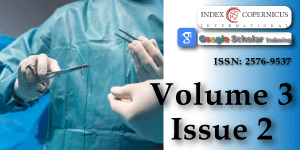Idiopathic post-operative biliary duct system dilatation; potential etiology and management
Main Article Content
Abstract
What is called “idiopathic biliary duct system dilatation” or better to name it “un-explained biliary dilatation” is mostly following surgical procedures related to upper gastrointestinal and hepato-bilio-pancreatic systems. Having such situation, adaptive physiology of the biliary duct system has to be considered and rational has to be explained. The vast multimodal progress in techniques of investigations that has been applied on studying the hepato-bilio-pancreatic system has been utilized to clear the clinical ambiguity of biliary duct system dilatation for no logic reason but missing the correlation between both fields; the technical and the clinical ones. This clinical review is trying to fill this gap and introduce a comprehensive discussion of the subject. Mechanical, biochemical and immune causes constitute a wide diversity of etiology related to biliary system dilatation that in some situations is really difficult to verify clinically. On the least, even we could not verify the etiology we need to identify that reaching a closed road is different than postulating suspicions that never exist. This review is a trial collecting all subject-related data that might be related to etiology mechanisms and utilize to find a correlation rationale. At some point verification of such correlation is really a far target that might be even impossible clinically with availing technical tools and hope in the future could be achieved.
Article Details
Copyright (c) 2019 Nasr MM, et al.

This work is licensed under a Creative Commons Attribution 4.0 International License.
Smith I, Monkemuller K, Wilcox CM. Incidentally Identified Common Bile Duct Dilatation A Systematic Review of Evaluation, Causes, and Outcome. J Clin Gastroenterol. 2015; 49: 810-815. PubMed: https://www.ncbi.nlm.nih.gov/pubmed/26302495
Ishibashi H, Shimada M, Kamisawa T, Fujii H, Hamada Y, et al. Japanese clinical practice guidelines for congenital biliary dilatation. J Hepatobiliary Pancreat Sci. 2017; 24: 1-16. PubMed: https://www.ncbi.nlm.nih.gov/pubmed/28111910
Park SM, Kim WS, Bae IH, Kim JH, Ryu DH, et al. Common bile duct dilatation after cholecystectomy: a one-year prospective study. J Korean Surg Soc. 2012; 83: 97-101. PubMed: https://www.ncbi.nlm.nih.gov/pubmed/22880184
Coss A, Enns R. The investigation of unexplained biliary dilatation. Curr Gastroenterol Rep. 2009; 11: 155-159. PubMed: https://www.ncbi.nlm.nih.gov/pubmed/19281704
Mehta N, Strong AT, Stevens T, El-Hayek K, Nelson A, et al. Common bile duct dilation after bariatric surgery. Surg Endosc. 2019; 33: 2531-2538. PubMed: https://www.ncbi.nlm.nih.gov/pubmed/30353239
Sharanek A, Burban A, Ciriaci N, Guillouzo A. Pro-inflammatory cytokines enhance dilatation of bile canaliculi caused by cholestatic antibiotics. Toxicol In Vitro. 2019; 58: 51-59. PubMed: https://www.ncbi.nlm.nih.gov/pubmed/30876886
Burban A, Sharanek A, Hüe R, Gay M, Routier S, et al. Penicillinase-resistant antibiotics induce non-immune-mediated cholestasis through HSP27 activation associated with PKC/P38 and PI3K/AKT signalng pathways. Sci Rep. 2017; 7: 1815. PubMed: https://www.ncbi.nlm.nih.gov/pubmed/28500348
De Angelis C, Marietti M, Bruno M, Pellicano R, Rizzetto M. Endoscopic ultrasound in common bile duct dilatation with normal liver enzymes. World J Gastrointest Endosc. 2015; 7: 799-805. PubMed: https://www.ncbi.nlm.nih.gov/pmc/articles/PMC4501970/
Kwon H, Reid S, Kim D, Lee S, Cho J, et al. Diagnosing common bile duct obstruction: comparison of image quality and diagnostic performance of three-dimensional magnetic resonance cholangiopancreatography with and without compressed sensing. Abdom Radiol. 2018; 43: 2255-2261. PubMed: https://www.ncbi.nlm.nih.gov/pubmed/29302736
Hollingsworth KG. Reducing acquisition time in clinical MRI by data under sampling and compressed sensing reconstruction. Phys Med Biol. 2015; 60: 297-322. PubMed: https://www.ncbi.nlm.nih.gov/pubmed/26448064
Ogawa M, Ozawa Y, Ohta K, Sekiguchi T, Omata S, et al. Usefulness of 3D balanced turbo-field-echo MR sequence evaluating the branching pattern of the intrahepatic bile ducts: comparison with drip infusion CT cholangiography. Abdom Radiol. 2017; 42: 1888-1895. PubMed: https://www.ncbi.nlm.nih.gov/pubmed/28260170
Ito K, Kanki A, Yamamoto A, Tamada T, Yasokawa K, et al. Assessment of physiologic bile flow in the extrahepatic bile duct with Cine-Dynamic MR Cholangiopancreatography and a Spatially Selective Inversion-Recovery Pulse. Radiology. 2014; 270: 777-783. PubMed: https://www.ncbi.nlm.nih.gov/pubmed/24475829





